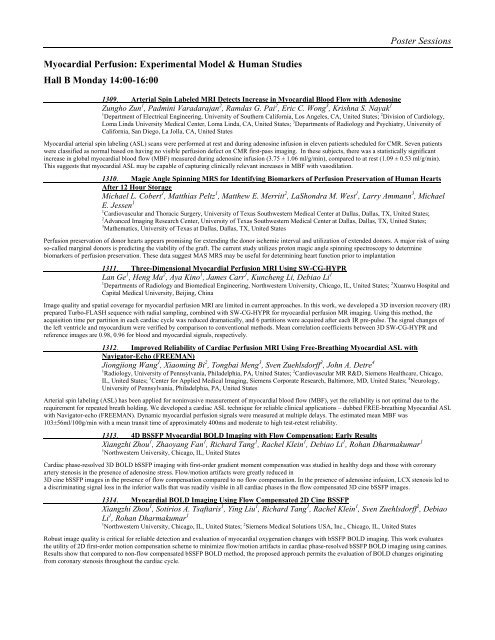TRADITIONAL POSTER - ismrm
TRADITIONAL POSTER - ismrm
TRADITIONAL POSTER - ismrm
Create successful ePaper yourself
Turn your PDF publications into a flip-book with our unique Google optimized e-Paper software.
Poster Sessions<br />
Myocardial Perfusion: Experimental Model & Human Studies<br />
Hall B Monday 14:00-16:00<br />
1309. Arterial Spin Labeled MRI Detects Increase in Myocardial Blood Flow with Adenosine<br />
Zungho Zun 1 , Padmini Varadarajan 2 , Ramdas G. Pai 2 , Eric C. Wong 3 , Krishna S. Nayak 1<br />
1 Department of Electrical Engineering, University of Southern California, Los Angeles, CA, United States; 2 Division of Cardiology,<br />
Loma Linda University Medical Center, Loma Linda, CA, United States; 3 Departments of Radiology and Psychiatry, University of<br />
California, San Diego, La Jolla, CA, United States<br />
Myocardial arterial spin labeling (ASL) scans were performed at rest and during adenosine infusion in eleven patients scheduled for CMR. Seven patients<br />
were classified as normal based on having no visible perfusion defect on CMR first-pass imaging. In these subjects, there was a statistically significant<br />
increase in global myocardial blood flow (MBF) measured during adenosine infusion (3.75 ± 1.06 ml/g/min), compared to at rest (1.09 ± 0.53 ml/g/min).<br />
This suggests that myocardial ASL may be capable of capturing clinically relevant increases in MBF with vasodilation.<br />
1310. Magic Angle Spinning MRS for Identifying Biomarkers of Perfusion Preservation of Human Hearts<br />
After 12 Hour Storage<br />
Michael L. Cobert 1 , Matthias Peltz 1 , Matthew E. Merritt 2 , LaShondra M. West 1 , Larry Ammann 3 , Michael<br />
E. Jessen 1<br />
1 Cardiovascular and Thoracic Surgery, University of Texas Southwestern Medical Center at Dallas, Dallas, TX, United States;<br />
2 Advanced Imaging Research Center, University of Texas Southwestern Medical Center at Dallas, Dallas, TX, United States;<br />
3 Mathematics, University of Texas at Dallas, Dallas, TX, United States<br />
Perfusion preservation of donor hearts appears promising for extending the donor ischemic interval and utilization of extended donors. A major risk of using<br />
so-called marginal donors is predicting the viability of the graft. The current study utilizes proton magic angle spinning spectroscopy to determine<br />
biomarkers of perfusion preservation. These data suggest MAS MRS may be useful for determining heart function prior to implantation<br />
1311. Three-Dimensional Myocardial Perfusion MRI Using SW-CG-HYPR<br />
Lan Ge 1 , Heng Ma 2 , Aya Kino 1 , James Carr 1 , Kuncheng Li, Debiao Li 1<br />
1 Departments of Radiology and Biomedical Engineering, Northwestern University, Chicago, IL, United States; 2 Xuanwu Hospital and<br />
Capital Medical University, Beijing, China<br />
Image quality and spatial coverage for myocardial perfusion MRI are limited in current approaches. In this work, we developed a 3D inversion recovery (IR)<br />
prepared Turbo-FLASH sequence with radial sampling, combined with SW-CG-HYPR for myocardial perfusion MR imaging. Using this method, the<br />
acquisition time per partition in each cardiac cycle was reduced dramatically, and 6 partitions were acquired after each IR pre-pulse. The signal changes of<br />
the left ventricle and myocardium were verified by comparison to conventional methods. Mean correlation coefficients between 3D SW-CG-HYPR and<br />
reference images are 0.98, 0.96 for blood and myocardial signals, respectively.<br />
1312. Improved Reliability of Cardiac Perfusion MRI Using Free-Breathing Myocardial ASL with<br />
Navigator-Echo (FREEMAN)<br />
Jiongjiong Wang 1 , Xiaoming Bi 2 , Tongbai Meng 3 , Sven Zuehlsdorff 2 , John A. Detre 4<br />
1 Radiology, University of Pennsylvania, Philadelphia, PA, United States; 2 Cardiovascular MR R&D, Siemens Healthcare, Chicago,<br />
IL, United States; 3 Center for Applied Medical Imaging, Siemens Corporate Research, Baltimore, MD, United States; 4 Neurology,<br />
University of Pennsylvania, Philadelphia, PA, United States<br />
Arterial spin labeling (ASL) has been applied for noninvasive measurement of myocardial blood flow (MBF), yet the reliability is not optimal due to the<br />
requirement for repeated breath holding. We developed a cardiac ASL technique for reliable clinical applications – dubbed FREE-breathing Myocardial ASL<br />
with Navigator-echo (FREEMAN). Dynamic myocardial perfusion signals were measured at multiple delays. The estimated mean MBF was<br />
103±56ml/100g/min with a mean transit time of approximately 400ms and moderate to high test-retest reliability.<br />
1313. 4D BSSFP Myocardial BOLD Imaging with Flow Compensation: Early Results<br />
Xiangzhi Zhou 1 , Zhaoyang Fan 1 , Richard Tang 1 , Rachel Klein 1 , Debiao Li 1 , Rohan Dharmakumar 1<br />
1 Northwestern University, Chicago, IL, United States<br />
Cardiac phase-resolved 3D BOLD bSSFP imaging with first-order gradient moment compensation was studied in healthy dogs and those with coronary<br />
artery stenosis in the presence of adenosine stress. Flow/motion artifacts were greatly reduced in<br />
3D cine bSSFP images in the presence of flow compensation compared to no flow compensation. In the presence of adenosine infusion, LCX stenosis led to<br />
a discriminating signal loss in the inferior walls that was readily visible in all cardiac phases in the flow compensated 3D cine bSSFP images.<br />
1314. Myocardial BOLD Imaging Using Flow Compensated 2D Cine BSSFP<br />
Xiangzhi Zhou 1 , Sotirios A. Tsaftaris 1 , Ying Liu 1 , Richard Tang 1 , Rachel Klein 1 , Sven Zuehlsdorff 2 , Debiao<br />
Li 1 , Rohan Dharmakumar 1<br />
1 Northwestern University, Chicago, IL, United States; 2 Siemens Medical Solutions USA, Inc., Chicago, IL, United States<br />
Robust image quality is critical for reliable detection and evaluation of myocardial oxygenation changes with bSSFP BOLD imaging. This work evaluates<br />
the utility of 2D first-order motion compensation scheme to minimize flow/motion artifacts in cardiac phase-resolved bSSFP BOLD imaging using canines.<br />
Results show that compared to non-flow compensated bSSFP BOLD method, the proposed approach permits the evaluation of BOLD changes originating<br />
from coronary stenosis throughout the cardiac cycle.















